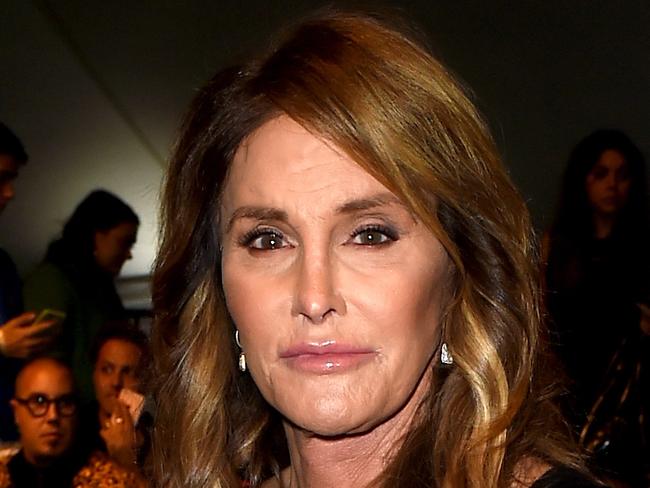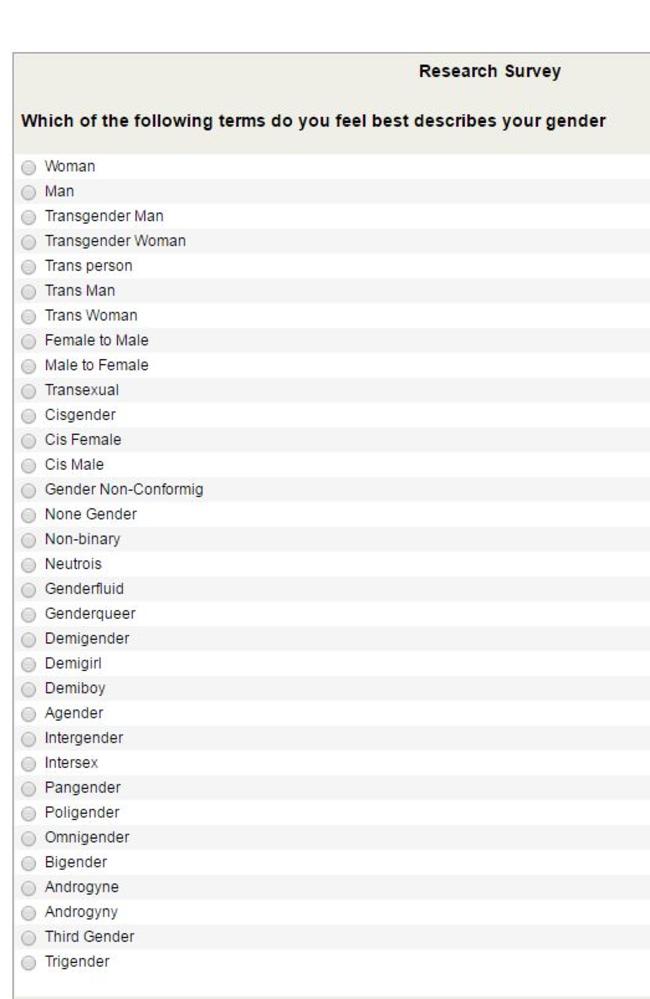This question about gender identity has 33 possible answers
THIS question on The Australian Sex Survey seems super simple, but there are 33 possible answers. Here we explain them all.

Sex
Don't miss out on the headlines from Sex. Followed categories will be added to My News.
IT SEEMS like a simple question: “Which of the following terms do you feel best describes your gender?”
But there are 33 possible responses to this question in The Australian Sex Survey, which is being conducted by researchers at The Queensland University of Technology (QUT).
They’ve partnered with The Australian Sex Party, AdultMatchmaker.com.au and adult industry lobby group The Eros Association to create a 15-minute anonymous survey about our sex lives.
“We’re looking at the changing face of gender and how that plays a part in making a decision about choosing a partner,” said QUT behavioural economist Stephen Whyte.
“Most people’s description of gender is very pigeonholed — either male or female — but there are so many new categories of different gender identities which allow people to identify across a spectrum,” he said.
The survey is open for the next eight weeks and the preliminary findings will be presented around Christmas.

The World Health Organisation defines gender as the “socially constructed roles, behaviours, activities, and attributes that a given society considers appropriate for men and women.”
Thanks to high profile transgender women like Caitlyn Jenner and Orange Is The New Black’s Laverne Cox, as well as shows like Transparent, our understanding of gender identity is expanding.
We now know that it’s possible for people not to identify with the gender they were born as. Plus, many people see gender is a fluid, non-binary concept. That is, they don’t identify as either a man or a woman.
For example, Ruby Rose identifies as gender fluid. “I am very gender fluid and feel more like I wake up every day sort of gender neutral,” Rose said recently.
With all this in mind, we’ve defined all 33 of these responses with some help from The Gender Centre.

Woman: A person born as a female, and who identifies as female.
Man: A person born as a male, and who identifies as a male.
Transgender Man: A person who was assigned female at birth, but now identifies as a man. Some trans people choose to undergo gender reassignment surgery. Others prefer not to, but still identify as a different gender.
Transgender Woman: A person who was assigned male at birth, but who identifies as a woman. As above, some trans people choose to undergo gender reassignment surgery. Others prefer not to, but still identify as a different gender.
Trans person: This can mean transsexual or transgender. A transsexual is a person who emotionally and psychologically feels that they belong to the opposite sex.
Trans Man: A trans man is someone who was assigned female at birth, but now identifies as a man.
Trans Woman: A person who was assigned male at birth, but who identifies as a woman
Female to Male: This term is often abbreviated to ‘FTM’ and refers to a transsexual or a transgender man.
Male to Female: This term is often abbreviated to ‘FTM’ and refers to a transsexual or a transgender female.
Transsexual: A person who emotionally and psychologically feels that they belong to the opposite sex. Transsexuals are people who transition from one sex to another, usually through dress, hormone therapy, etc.
Cisgender: A person who identifies with the gender of which they were born. For example, if someone is born as a female and identifies as a woman.
Cis Female: Cis is short for cisgender. So a cisgender female is a female who identifies as a woman.
Cis Male: Cis is short for cisgender. A cisgender male is a male who identifies as a man.
Gender Non-Conforming: A person who does not identify with either the male of female genders.
None Gender: A person who does not identify with any gender in particular.
Non-Binary: A person who does not identify entirely with either the female or male genders. They may identify somewhere on a spectrum.
Neutrois: Neutrois is a non-binary gender identity which is considered to be a neutral or null gender.
Genderfluid: A person who does not identify entirely with either the female or male genders.
Genderqueer: An overarching term used to describe people who do not identify exclusively as either male or female.
Demigender: This term, (demi means half) is an umbrella term for nonbinary gender identities that have a partial connection to a certain gender.
Demigirl: A person (can also be called a demiwoman or a demifemale) who identifies partially with being a woman or has feminine characteristics. They may have been assigned female as birth, but they could also have been born as a male.
Demiboy: A person (can also be called a demiman or demimale) who identifies partially with being a man or masculine characteristics. They may have been assigned male at birth, but they could also have been born as a female.
Agender: This literally means ‘without gender’, so a person who doesn’t identify with any gender.
Intergender: Intergender people have a gender identity that is in the middle between the binary genders of female and male, and may be a mix of both.
Intersex: A person who is born with the reproductive anatomy of both a man and a woman. For example, they might appear to be female on the outside, but have mostly male-typical anatomy on the inside. These people were previously referred to as hermaphrodites, but that term is considered rude and outdated.
Pangender: A person who identifies as more than one gender.
Poligender: Translates to ‘many genders’. A person who identifies as more than one gender.
Omnigender: Translates to ‘all genders’. A person who identifies as more than one gender.
Bigender: Translates to ‘two genders’. A person who identifies as both male and female genders. Some bigender people have two distinct male and female personas.
Androgyne: A person who doesn’t identify with either gender. They are both feminine and masculine.
Androgyny: The combination of masculine and feminine characteristics. Androgyny can apply to many things - someone’s gender identity, sexual identity, and even fashion.
Third Gender: People who identify as neither a man nor a woman. Some cultures refer to some of their people by a third gender.
For example, in Samoafa’afafines are male at birth, but if a family had more boys than girls and needed more women to help with housework, they male children would be raised as a fa’afafine.
Trigender: Translates to three genders. A person who shifts between the male, female and third genders.
rebecca.sullivan@news.com.au
Originally published as This question about gender identity has 33 possible answers


